As the host destination for Latin America’s 50 Best Restaurants 2022, the eastern Mexican state of Yucatán is full of still-under-the-radar foodie surprises. Ahead of the new list being announced in Mérida on 15th November, local journalist and passionate gourmet Gabriela Rentería gives the low-down on the restaurants, dishes and experiences you don’t want to miss
Looking at a map of Mexico, lying across the Gulf and the Caribbean Sea you will find Yucatán – home to some of the most intense and provocative culinary experiences in the Latin American region. In the last decade, its capital Mérida has become a hub for those living in the surrounding towns and countryside, who find fresh opportunities, a city full of colour and culture and a unique mix of the old and the new in the growing metropolis.
The White City, as Mérida is known (Ciudad Blanca in Spanish, a name inspired by the reflection of sunlight over limestone, which many of its most emblematic buildings are built from) hosts a wide variety of culinary experiences. From the most traditional and ancestral recipes found in markets and on the street, to fine dining establishments that bring to the table the flavours and colours of local ingredients and Mayan techniques, it's no surprise that Mérida is fast becoming a dream destination for food lovers – and a fitting host for the first full post-pandemic edition of Latin America’s 50 Best Restaurants, sponsored by S.Pellegrino & Acqua Panna.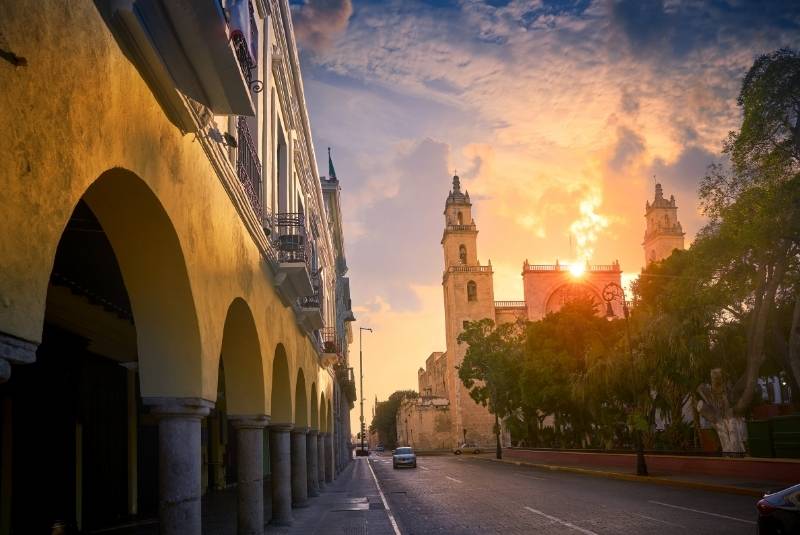
The city of Mérida in Yucatán will host the 10th edition of Latin America's 50 Best Restaurants in 2022
The past in the present
It all started thousands of years ago: one of the most ancient civilizations in the world, with the first settlements dating back to 1,800 B.C. and monumental cities flourishing by the fourth century B.C., the Mayans lived in the south of Mexico and across various countries in Central America.
Monumental architecture (with well-preserved cities such as Chichen Itza), traditions passed down the centuries and cultural empowerment provide a present-day reminder of the civilization’s sophistication and development. Many of the Mayan traditions still strong in Yucatán are food oriented: ancient endemic ingredients form the foundation of the dishes that represent the Yucatán Peninsula – flavours that have become representative of Mexico throughout the world.
“We can begin to describe Yucatecan gastronomy with a timeline that starts with cocina de origen [origin cuisine], with our most basic and ancestral ingredients such as maíz [corn], frijoles [beans] and calabaza [pumpkin],” explains Wilson Alonzo, local chef and recognised culinary researcher.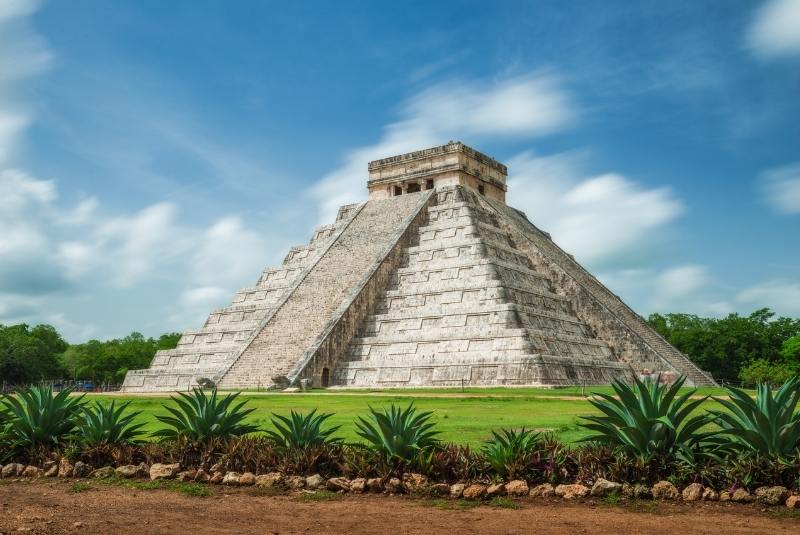
Chichen Itza, a complex of Mayan ruins on Mexico's Yucatán Peninsula
The next stage was cocina mestiza (hybrid cuisine), developed after the Spanish conquest with the ingredients brought from Europe to the American continent, such as pork. “Pork lard became an essential ingredient in many traditional recipes, alongside spices and seeds that only grow in the Mayans’ native land. This mix forms the basis for soups and stews that have become iconic in local gastronomy. For instance, there is the bulb of achiote, the source of annatto seeds, now the essence of our best-known traditional dish: cochinita pibil,” continues Alonzo.
“The Asian migration gave us the deep-frying cooking technique, another important contribution to our culinary culture, through which we developed panuchos [stuffed refried tortillas], salbutes [puffed corn tortillas] and empanadas [filled turnovers], today some of the Yucatecan flavours most popular around the world.
“At the beginning of the 21st century, the era of contemporary gastronomy began. Recipes that mix local ingredients with those that came with international migrations feature in this period, like the famous poc chuc [meat marinated in citrus and grilled],” concludes Alonzo.
These ancient recipes and flavours are still preserved by traditional cooks and remain a key part of home cooking, markets and street vendors who make gastronomic culture accessible to locals and tourists every day in the towns and cities of Yucatán.
From Mérida with love
You can smell delicious food and the intense aroma of chilis and spices in many corners of the White City. Tacos and tortas, a kind of Mexican sandwich, filled with cochinita (slow-roasted pork), relleno negro (a filling made with turkey, pork and chilli peppers) or lechón (suckling pig) can be found in any neighbourhood. Word of mouth, following your nose or simply coming across long queues of hungry customers can all be good ways to find family restaurants that preserve and celebrate local flavours.
As in other cities in Mexico, markets are a must-visit destination to dig deeper in the cultural roots of the region. Full of colours and folklore, they are ever popular with locals sourcing ingredients or looking for good snacks for breakfast or lunch. One of Mérida’s best and biggest markets is the Mercado Lucas de Galvez, located close to the city centre. Alongside its amazing flower market, you’ll find women selling recado, an ancestral spice mix that forms the base for cochinita, as well as relleno negro and relleno blanco – some of the best-known fillings in the whole state. It is also easy to find authentic Yucatecan-style tamales (corn dough steamed in corn husk or banana leaf), atoles (a traditional hot corn beverage) and tacos.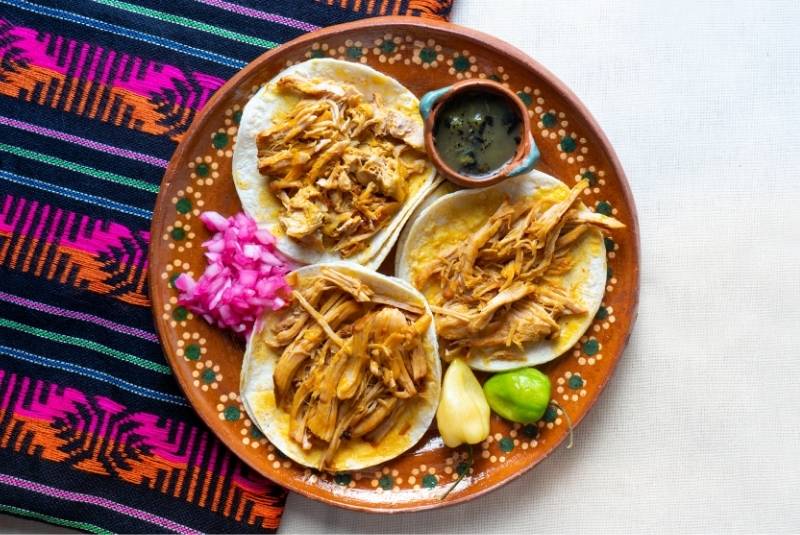
Traditional cochinita pibil tacos, with slow-roasted pork and zesty citrus garnish
A local favourite is Taquería La Lupita, located in the Mercado de Santiago, famous for its outstanding lechón and cochinita pibil tacos. Make sure you don’t miss the chance to try their tortas de relleno negro, a local Yucatecan delicacy.These antojitos – a word loosely translated as ‘little cravings’ and used to refer to savoury snacks and pre-meal bites in Mexico – pair well with a good beverage and Yucatán has one of the best: horchata, a concoction of boiled rice and cinnamon that has become popular across the country.
Another widespread antojito finds its origins in Lebanese food culture. Locally known as kibi, it’s very similar to the traditional Lebanese kipe, only made with a different spice mix and served with other sides – Yucatecans love to pair it with red onion, cabbage and habanero chili. Street stalls selling kibis are ubiquitous in local markets and at sports stadiums.
Influences near and far
Fusion is a natural element of Mexican cuisines. Every area of the country experienced different migrations that transformed and magnified its ingredients and traditional recipes. In Yucatán, the arrival of people from Lebanon forever changed the way locals eat. “This food culture is very close to Mexican culinary tradition: big tables, lots of different flavours mixed together, ancient techniques and that all-important homey feeling,” says Antonio Bachour, a recognised chef who recently opened Habibi, an elegant, modern Lebanese restaurant in Mérida.
This culinary coming-together doesn’t only emanate from other countries, but also from other states in Mexico. Over the last few years, many young chefs have moved to Mérida, bringing new flavours, ideas and experiences that are renewing local gastronomy.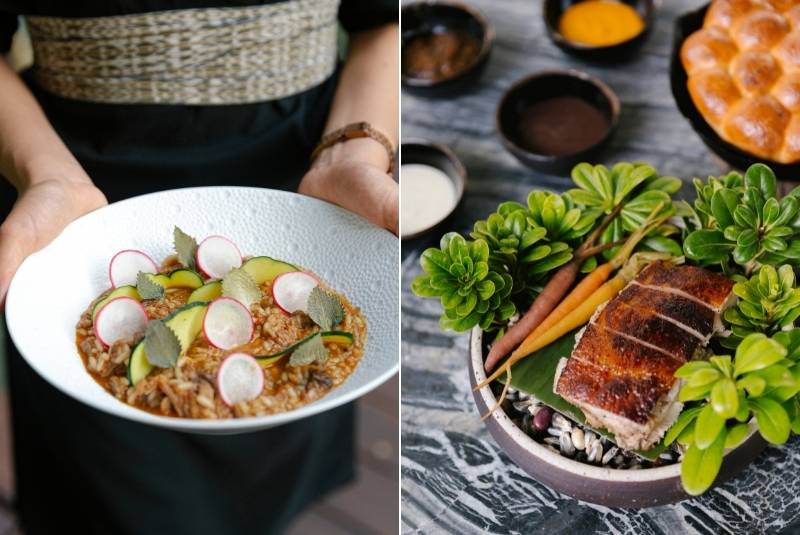
Chef Jorge Vallejo of Quintonil devised the menu for Ixi'im (images: Ixi'im Restaurant)
Ixi’im restaurant, located in the Chablé hotel resort outside the city, is a great example of this new fusion. Executive chef Jorge Vallejo (of Quintonil fame) and chef Luis Ronzón, both hailing from Mexico City, create authentic flavours mixing the best ingredients from Mayan culture, such as oregano, sour orange, pork and local cheese, with flavours from other regions of the country and different techniques. The result is layered, attention-grabbing and definitely worth a try.
Other noteworthy culinary projects include: Micaela Mar y Leña, which recreates authentic Mexican recipes from diverse latitudes; Pancho Maiz, a new, fast-growing humble restaurant that promotes the ethical use of corn; and Cuna, helmed by Venezuelan chef Maycoll Calderón, who crafts seasonal menus with the best-quality produce from the region. 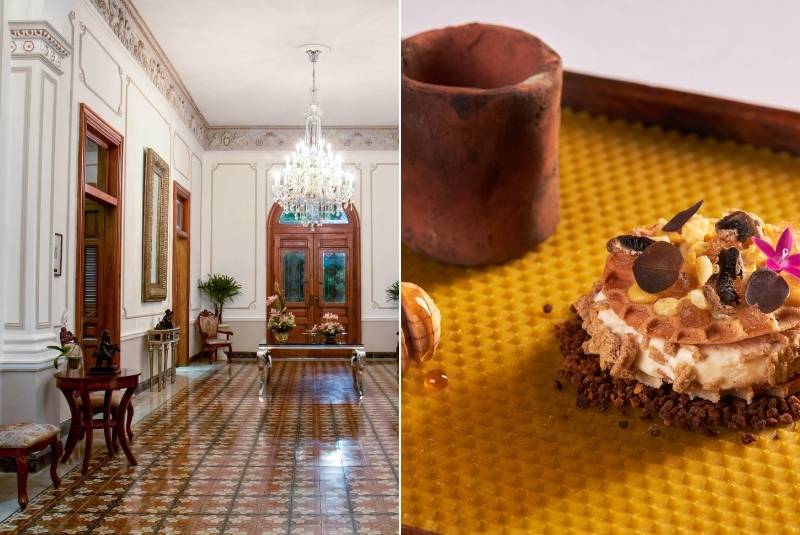
Chef Pedro Evia serves modernised dishes with traditional Yucatecan flavours at K'u'uk (images: K'u'uk Restaurant)
All these new venues would not exist without those that started elevating traditional cuisine years ago. Nectar was the first fine-dining restaurant in Yucatán, opened by chef Roberto Solís in 2003 and widely regarded as the birthplace of new Yucatecan gastronomy, with dishes as tacos al pastor negro that changed the way Yucatecan food was perceived across Latin America. While Nectar is still one of the most important restaurants in the city, Solís also recently opened Huniik, a more casual dining experience that conveys modern Yucatecan cuisine.
Chef Pedro Evia is also among the visionaries responsible for evolving local food to a super-premium level: his restaurant, K’u’uk, shows how ancient flavours and culture can be reconstructed and redeveloped. Hosted in a colonial house, it represents history, nature and the amazing flavours that Yucatán wants to share with the world.
The upcoming edition of Latin America’s 50 Best Restaurants, sponsored by S.Pellegrino & Acqua Panna, will be announced on Tuesday 15th November 2022. To be the first to hear about the latest news and announcements, follow us on Instagram, find us on Facebook, visit us on Twitter and subscribe to our YouTube channel.

